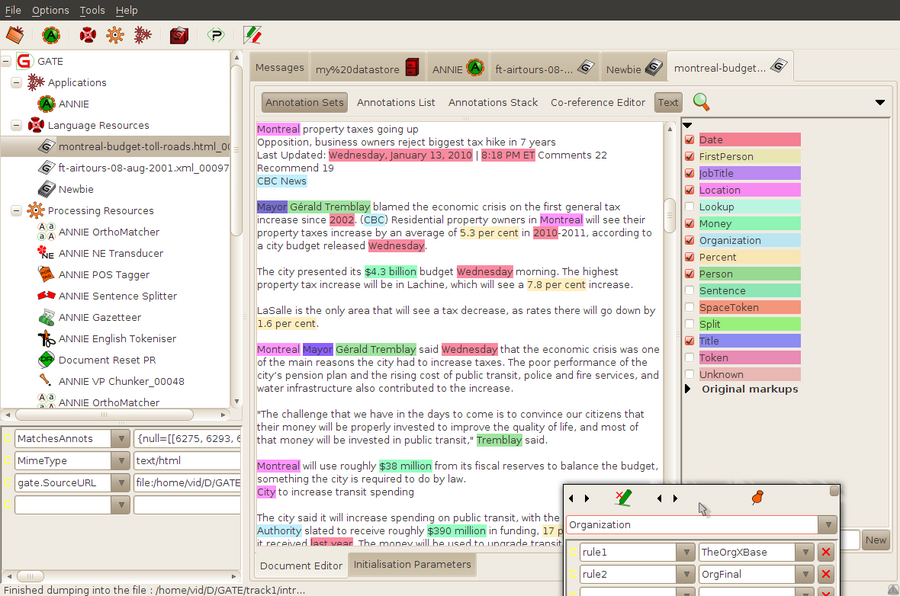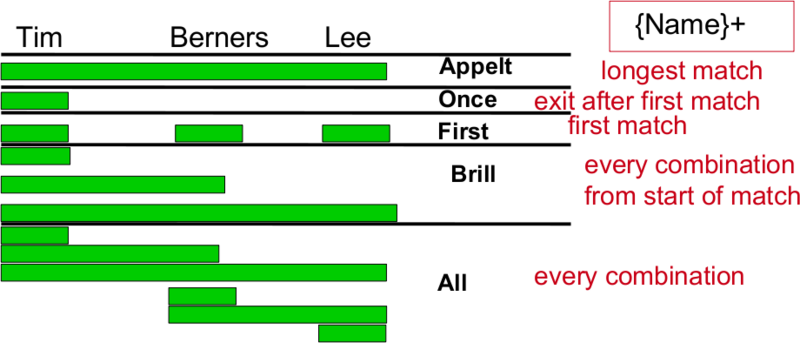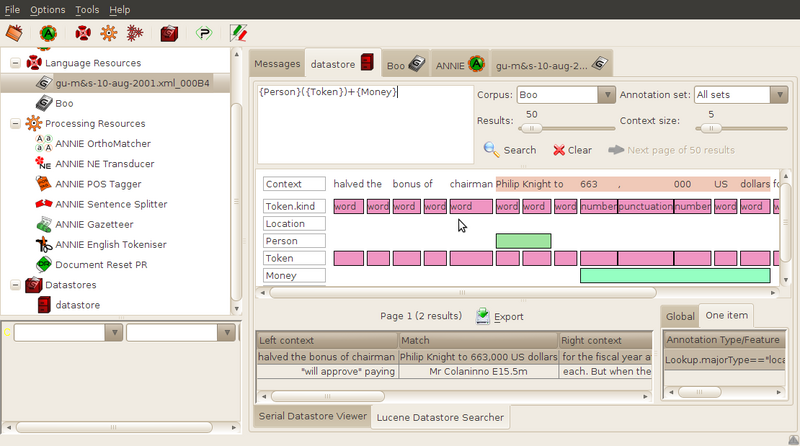GATE track 1 session: Difference between revisions
No edit summary |
|||
| (21 intermediate revisions by the same user not shown) | |||
| Line 1: | Line 1: | ||
A full week of learning GATE text mining/information extraction language processing and talks. [http://gate.ac.uk/wiki/TrainingCourseAug2010/ Session wiki] | A full week of learning [http://en.wikipedia.org/wiki/General_Architecture_for_Text_Engineering GATE] text mining/information extraction language processing and talks. [http://gate.ac.uk/wiki/TrainingCourseAug2010/ Session wiki] | ||
[[File:GATE_screenshot.png|900px|GATE developer screenshot]] | [[File:GATE_screenshot.png|900px|GATE developer screenshot]] | ||
| Line 20: | Line 20: | ||
* Learning Systems - statistical | * Learning Systems - statistical | ||
Old Bailey IE project - | Old Bailey IE project - 17th century english (Online) | ||
* POS - assigned in Token (noun, verb, etc) | * POS - assigned in Token (noun, verb, etc) | ||
* Gazateer - gotcha, have to set initialization parameter listsURL before it's | * Gazateer - gotcha, have to set initialization parameter listsURL before it's loaded. Must also "save and reinitialize." | ||
loaded. Must also "save and reinitialize." | |||
* Gazeteer creates Lookups, then transducer creaties named entities | * Gazeteer creates Lookups, then transducer creaties named entities | ||
* Then orthomatcher (spelling features in common) coreference associates those | * Then orthomatcher (spelling features in common) coreference associates those | ||
| Line 36: | Line 35: | ||
* Evaluation metric - mathematically against human annotated | * Evaluation metric - mathematically against human annotated | ||
* Scoring - performance measures for annotation types | * Scoring - performance measures for annotation types | ||
* Precision = correct / correct + spurious | |||
* Recall = correct / correct + missing | |||
* F-measure is precision and recall (harmonic mean) | |||
* F=2⋅(precision⋅recall / precision+recall) | |||
* GATE supports average, strict, lenient | |||
* Result types - Correct, missing, spurious, partially correct (overlapped) | * Result types - Correct, missing, spurious, partially correct (overlapped) | ||
| Line 47: | Line 52: | ||
** useful for eg HTML that has boilerplate | ** useful for eg HTML that has boilerplate | ||
== To investigate == | |||
* markupAware for HTML/XML (keeps tags in editor) | * markupAware for HTML/XML (keeps tags in editor) | ||
| Line 56: | Line 62: | ||
* Rules based on tokens and lookups | * Rules based on tokens and lookups | ||
Phase: MatchingStyles | |||
Input: Lookup | |||
Options: control = appelt | |||
Rule: Test1 | |||
( | |||
({Lookup.majorType == location})? | |||
{Lookup.majorType == loc_key} | |||
):match | |||
--> | |||
:match.Location = {rule=Test1} | |||
Copying features: :match.Location = { type = :match.Lookup.minorType} | |||
== To review, gotchas == | == To review, gotchas == | ||
| Line 65: | Line 84: | ||
* macros | * macros | ||
* To reuse created annotations has to be a separate rule | * To reuse created annotations has to be a separate rule | ||
=== Matching types === | |||
[[File:gate-matching.png|800px|Matching styles for JAPE]] | |||
= To follow up = | |||
* WebSphinx crawler CREOLE plugin | |||
* [http://www.semanticsoftware.info/semantic-assistants-architecture GATE NLP web services] | |||
= Other notes = | |||
== Lucene data store and ANNIC == | |||
* Use <null> for default set | |||
* Go to Datastore for queries | |||
** eg {Person}({Token})+{Money} | |||
* Useful for debugging JAPE and results | |||
[[File:GATE-lucene-person-money.png|800px]] | |||
= Demos = | |||
* Mímir for querying large volumes of data (uses MG4J) | |||
* Translating parts of speech between languages using Compound editor and Alignment editor | |||
* Predicate extractor (MultiPaX) | |||
** Mixed results at best | |||
* OwlExporter | |||
** NLP ontology | |||
= Conclusions = | |||
While it can do a lot out of the box and benefits from development time and breadth of connectivity, to be useful to more than patient specialists, it needs usability testing. A lot of things are inobvious and too domain specific that with a bit of work could be more broadly useful. Interaction could include a lot more immediate, useful and interesting looking displays. A web based version could have these features. However the team seems somewhat ambivalent about development. :) | |||
Looking forward to learning about programming using GATE libraries. | |||
{{Blikied|Aug 30, 2010}} | {{Blikied|Aug 30, 2010}} | ||
[[Category:SemWeb]] | [[Category:SemWeb]] | ||
Latest revision as of 01:10, 10 September 2010
A full week of learning GATE text mining/information extraction language processing and talks. Session wiki
GATE is written in Java and very Java centric. This makes it portable, fast, and heavyweight. A programming library is available. It's 14 years old and has many users and contributors.
Using GATE developer
- GATE developer is used to process sets of Language Resources in Corpus using Processing Resources. They are typically saved to a serialized Datastore.
- ANNIE, VG (verb group) processors.
- Preserve formatting embeds tags in HTML or XML.
- Different strengths using GATE's graph (node/offset) based XML vs. preserved formatting (original xml/html)
Information Extraction
- IR - retrieve docs
- IE - retreive structured data
- Knowledge Engineering - rule based
- Learning Systems - statistical
Old Bailey IE project - 17th century english (Online)
- POS - assigned in Token (noun, verb, etc)
- Gazateer - gotcha, have to set initialization parameter listsURL before it's loaded. Must also "save and reinitialize."
- Gazeteer creates Lookups, then transducer creaties named entities
- Then orthomatcher (spelling features in common) coreference associates those
- Annotation Key sets and annotation comparing
- Need setToKeep key in Document Reset for any pre annotated texts
Evaluation / Metrics
- Evaluation metric - mathematically against human annotated
- Scoring - performance measures for annotation types
- Precision = correct / correct + spurious
- Recall = correct / correct + missing
- F-measure is precision and recall (harmonic mean)
- F=2⋅(precision⋅recall / precision+recall)
- GATE supports average, strict, lenient
- Result types - Correct, missing, spurious, partially correct (overlapped)
- Tools > Annotations Diff - comparing human vs machine annotation
- Corpus > Corpus quality assurance - compare by type
- (B has to be the generated set)
- Annotation set transfer (in tools) - transfer between docs in pipeline
- useful for eg HTML that has boilerplate
To investigate
- markupAware for HTML/XML (keeps tags in editor)
- AnnotationStack
- Advanced Options
JAPE
- Rules based on tokens and lookups
Phase: MatchingStyles
Input: Lookup
Options: control = appelt
Rule: Test1
(
({Lookup.majorType == location})?
{Lookup.majorType == loc_key}
):match
-->
:match.Location = {rule=Test1}
Copying features: :match.Location = { type = :match.Lookup.minorType}
To review, gotchas
- Rule types : first takes only first match, excludes compound
- a? b for "a b" will match "a b"
- multiplexor tranducers
- multi-constraint statements
- macros
- To reuse created annotations has to be a separate rule
Matching types
To follow up
- WebSphinx crawler CREOLE plugin
- GATE NLP web services
Other notes
Lucene data store and ANNIC
- Use <null> for default set
- Go to Datastore for queries
- eg {Person}({Token})+{Money}
- Useful for debugging JAPE and results
Demos
- Mímir for querying large volumes of data (uses MG4J)
- Translating parts of speech between languages using Compound editor and Alignment editor
- Predicate extractor (MultiPaX)
- Mixed results at best
- OwlExporter
- NLP ontology
Conclusions
While it can do a lot out of the box and benefits from development time and breadth of connectivity, to be useful to more than patient specialists, it needs usability testing. A lot of things are inobvious and too domain specific that with a bit of work could be more broadly useful. Interaction could include a lot more immediate, useful and interesting looking displays. A web based version could have these features. However the team seems somewhat ambivalent about development. :)
Looking forward to learning about programming using GATE libraries.


